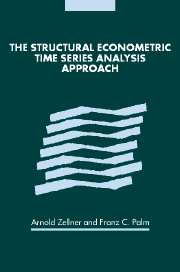Book contents
- Frontmatter
- Contents
- List of contributors
- Acknowledgments
- Introduction
- Part I The SEMTSA approach
- Part II Selected applications
- Part III Macroeconomic forecasting and modeling
- Part IV Disaggregation, forecasting, and modeling
- 20 Using Bayesian techniques for data pooling in regional payroll forecasting (1990)
- 21 Forecasting turning points in metropolitan employment growth rates using Bayesian techniques (1990)
- 22 A note on aggregation, disaggregation, and forecasting performance (2000)
- 23 The Marshallian macroeconomic model (2000)
- 24 Bayesian modeling of economies and data requirements (2000)
- Subject index
- Author index
- References
24 - Bayesian modeling of economies and data requirements (2000)
Published online by Cambridge University Press: 24 October 2009
- Frontmatter
- Contents
- List of contributors
- Acknowledgments
- Introduction
- Part I The SEMTSA approach
- Part II Selected applications
- Part III Macroeconomic forecasting and modeling
- Part IV Disaggregation, forecasting, and modeling
- 20 Using Bayesian techniques for data pooling in regional payroll forecasting (1990)
- 21 Forecasting turning points in metropolitan employment growth rates using Bayesian techniques (1990)
- 22 A note on aggregation, disaggregation, and forecasting performance (2000)
- 23 The Marshallian macroeconomic model (2000)
- 24 Bayesian modeling of economies and data requirements (2000)
- Subject index
- Author index
- References
Summary
Introduction
For many years, theoretical and empirical workers have tried to model national economies in order to (1) understand how they operate, (2) forecast future outcomes, and (3) evaluate alternative economic policies. While much progress has been made in the decades since Tinbergen's pioneering work [1940], it is the case that no generally accepted model has as yet appeared. On the theoretical side, there are monetary, neo-monetary, Keynesian, neo-Keynesian, real business cycle, generalized real business cycle, and other theoretical models (see, Belongia and Garfinkel 1992 for an excellent review of many of these models and Min 1992 for a description of a generalized real business cycle model). Some empirical testing of alternative models has appeared in the literature. However, in Fair (1992) and Zellner (1992) (invited contributions to a St. Louis Federal Reserve Bank conference on alternative macroeconomic models), it was concluded that there is a great need for additional empirical testing of alternative macroeconomic models and production of improved models.
Over the years many structural econometric and empirical statistical models have been constructed and used. These include large structural econometric models (e.g. the Tinbergen, Klein, Brookings–SSRC, Federal Reserve–MIT–PENN, OECD, Project Link, and other models). While progress has been made, there does not yet appear to be a structural model that performs satisfactorily in point and turning point forecasting.
Information
- Type
- Chapter
- Information
- The Structural Econometric Time Series Analysis Approach , pp. 677 - 706Publisher: Cambridge University PressPrint publication year: 2004
References
Accessibility standard: Unknown
Why this information is here
This section outlines the accessibility features of this content - including support for screen readers, full keyboard navigation and high-contrast display options. This may not be relevant for you.Accessibility Information
- 1
- Cited by
